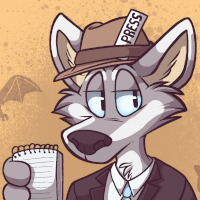(Note from Patch: Thanks to poppa bookworm for formatting. Fred’s review was held for a while, because the author didn’t feel comfortable about criticism in it. There was opportunity to revise the book itself, but that didn’t happen for months, so now we’re putting it out anyways. Honestly, I think the book concept sounds really fun and imaginative, which can be highly entertaining even combined with horrible execution. Think: Troma movies. I’d pick this up before many mainstream books!)
Submitted by Fred Patten, Furry’s favorite historian and reviewer.
Twisted, by Miranda Leek. [2nd edition.] Illustrated by the author.
Bloomington, IN, AuthorHouse, July 2014, trade paperback $26.95 (533 pages), Kindle $3.99.
This novel does not acknowledge that it is a second edition, but if you look at its Amazon.com entry, the first edition, May 2010, is still for sale right under it. The first edition is 376 pages, this is 533 pages, so it has at least been expanded. The first edition identifies the author as 17 years old; by the second, she is 22. Hopefully the four-year difference also includes an improvement in the writing, because the writing is still pretty bad.
The concept is certainly unique, as far as I know: anthropomorphic amusement park rides! The hero is Railrunner, a red roller coaster. The villain is Ironwheel, a black roller coaster. The setting is “Amusement Park Between”, a dimension consisting only of a vast world inhabited solely of living amusement park rides. The narrator is Rodney Philips, a young man whose previous employer has gone out of business and who is desperate for any kind of new job. He answers a newspaper advertisement for Mystic Park’s new roller coaster engineer, and learns that he is perfect for the job — in fact, he is a were-roller coaster!
Twisted introduces more than anthropomorphic roller coasters, particularly when it moves into “Part Two: The Land of Wonder and War”; the world of Amusement Park Between. There are Merrylegs, a gaudy carousel unicorn; Static, a blue-&-green dodgem car; Moonhoof, another carousel horse; Angeltrack, Railrunner’s mother (yes, Railrunner is freaked out at realizing that he was born as a baby roller coaster by a roller coaster mother); Freakshow, Ironwheel’s roller coaster general; Havoctrack, a salty roller coaster sea captain; Spiderleg, an eight-hydraulic-armed spider ride; a nameless go-kart, and many others. There is the whole world, which is much more than just an endless amusement park:
“I poured myself another round of wine. ‘What is that?’ I queried.
‘Where all red roller coasters have called home: the sacred Temple of the Red. There is where Thunderbark will train you, and that, Railrunner, is where you will fully discover all of what you are. The Temple is about a two-day journey from here. It lies beneath the surface of the great Achterbahn River, within the island of Quinet, past the town of Trenzon. The temple is an amazing thing, made entirely of gold, a castle fit for a king and his nobles.” (p. 155)
Er – I’m having a hard time visualizing a solid-gold castle-temple beneath a river. In fact …
Twisted is one of those rare novels that you can nitpick to pieces all day, and it still remains surprisingly readable. Read the rest of this entry »
 Roi Ours, by Mobidic.
Roi Ours, by Mobidic.






 The first edition of A Whisper of Wings was arguably the first professional furry specialty press book ever published, by Vision Novels in October 1999. Anything before that was really a fanzine calling itself a book.
The first edition of A Whisper of Wings was arguably the first professional furry specialty press book ever published, by Vision Novels in October 1999. Anything before that was really a fanzine calling itself a book. 45 pages), Kindle $2.99.
45 pages), Kindle $2.99.
